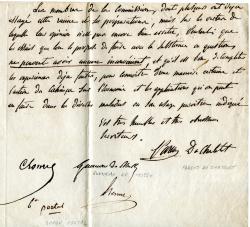
Manuscript Report to the Secretary General of the Hospitals and Hospices of Paris, by a commission investigating the medicinal qualities of the cahinca root. In Parent de Chatelet's hand and signed by him and the other four members of the commission.
Foolscap (leaf dimensions 42 x 26.5 cm), 1 p. Clear and complete. On the recto of the first leaf of a bifolium. Both leaves with the small neat ownership stamp of the 'Collections Louis Leguay, à Paris [series A, number 382]'. Good, on lightly-aged watermarked laid paper. Written in French. Addressed 'A Monsieur le Secretaire general des hopitaux et hospices de Paris'. The Commission charged with the examination of new and extraordinary medicines of possible use in the hospitals and hospices of Paris resumed its sitting at the house of its president Baron Portal on 29 April 1830, to examine whether it was appropriate to introduce 'dans la pratique des hopitaux, la racine de Cahinça [the cahinca root], non comprise dans le Codex'. Several of the members of the Commission have already tried 'cette racine et ses preparations', but have not yet arrived at an opinion on its 'vertus'. There can be no disadvantage in completing the proposed tests on the 'substance en question', and it would be good to complete the 'experiences deja faites, pour connoitre d'une maniere certain' both the action of cahinca 'sur l'economie' and 'les applications qu'on peut en faire dans les diverses maladies' for which its use would appear to be indicated. Signed 'Parent Du Chatelet', 'Chomet', Gueneau de Mussy', 'Bn Portal' and ''. In 1833 the American Journal of the Medical Sciences could report that cahinca had 'never before appeared in our Dispensatories', but twelve years later Wood and Bache could state ('Dispensatory of the United States') that it had 'attracted at one time considerable attention'. Cahinca originated in Brazil, where the natives used it as a cure for snakebite. On its introduction into Europe the celebrated French chemists Caventou and Pelletier discovered 'four distinct principles'.


